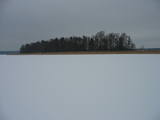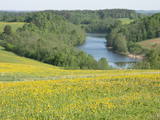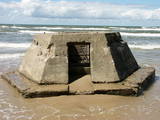| Nr | Nosaukums | Apraksts |
|---|---|---|
|
Astravo muižas saimniecība – viena no izteiksmīgākajām 19.gs. romantisma arhitektūras saimniecībām Lietuvā. Tā atrodas Astravā, Širvēnu ezea pussalā, kājām viegli sasniedzama no Biržiem pār garāko Lietuvā koka gājēju – Širvenos ezera tiltu. 18 ha jaukta plāna parks iekopts 1851. – 1862. Gadados. Parkā aug vietējie augi – egles, mazlapu liepas, priedes. |
||
|
Kartavkalnā, kur senāk atradusies seno zemgaļu apmetne, ir izveidota dabas taka ar soliņiem, piknika vietām. Šeit apskatāms arī Jaunpils Kartavu kalns un lapegļu aleja, kā arī iespējams aplūkot, kāda izskatās senlatviešu apmetne ar īstu guļbaļķu sētu.
|
||
|
Viens no pirtnieku autoritātēm un skolotājiem Ziedonis Kārkliņš rituālos izmanto daudzu dažādu pirts slotu enerģētisko iedarbību, vienā pirts reizē tiek izmantotas 12 un vairāk dažādu augu slotas, dabiskā kosmētika un dabas materiāli (māls, dzintars, dūņas, akmeņi u.c). Pirtnieks pielieto senās Baltu enerģētiskās zīmes. Piedāvājumā: apmācības par ārstniecības augiem, Baltu zīmēm, reiki. |
||
|
Lielā Baltezera sešas salas – Auzu, Priežu, Mazā, Liepu, Ropažu un Meldru sala izceļas ar lielu augu sugu un platlapju, melnalkšņu, priežu mežu daudzveidību. Teritorija labi pārskatāma no Ādažu luterāņu baznīcas puses, vai arī braucot ar laivu pa ezeru. Lielais Baltezers ir iecienīta makšķerēšanas (ziemā – zemledus) vieta.
|
||
|
Dodieties ekskursijā, lai gūtu ieskatu lauku profesijā un dzīvesveidā, kā arī iegūtu jaunus iespaidus un labu atpūtu visai klasei. Ekskursijas laikā apciemojiet koka skulptūras Vienkoču parkā, kur iespējams iepazīties arī ar koka amatniecību un sameklēt dārgumu lādi. Vai arī apmeklējiet vienīgo vietu Baltijā, kur var iepazīties ar cilvēku dzīves apstākļiem pirms vairāk kā 1000 gadiem. Pēc tam apmeklējiet zemnieku saimniecību, kurā no cidonijām ražo sukādes, marmelādes, sīrupus un citus labumus, un pļavās ganās savvaļas zirgi. Ekskursijas noslēgumā dodieties uz Porcelāna fabriku, lai varētu padarboties apgleznošanas darbnīcā un iepazīties ar ražotni. |
||
|
SIA "Ķiploku pasaule" nodarbojas ar ķiploku audzēšanu un to pārstrādi. Saimniece savā darbnīcā Olaines novadā, Uzvaras Līduma "Annās" pieņem grupas, rīko degustācijas un stāsta par savu darbību. Apmeklējuma laikā varēs nobaudīt ķiploku tēju, marinētus ķiploku ziedus, ķiploku pesto, "rīkļu rāvēju", neierastās ķiploku karameles un citus gardumus, kā arī iegādāties produktus uz vietas. |
||
|
Dabas parks veidots Latgales augstienes Dagdas pauguraines izteiktākās daļas un Baltijas dziļākā ezera (63,1 m) – Drīdza, tā salu (kopā – 9 salas), Ota ezera un to apkārtnes aizsardzībai. Skaistākie skati paveras no senā latgaļu pilskalna – Sauleskalna un Drīdza ezera austrumu daļā. Ezera krastos pieejamas naktsmītnes. |
||
|
No baterejas līdz mūsdienām ir saglabājušās dzelzsbetona dzota paliekas, kas ilgstošā vēja un viļņu darbības rezultātā, noskalojot krastu, ir noslīdējušas līdz pat liedagam. Interesants vēstures piemineklis, kura liktenis ilgtermiņā ir nojaušams – tas pazudīs zem jūras līmeņa.
|
||
|
Vienu kilometru garā lokveida taka, kas ved pa lielāku nacionālā parka meža masīvu, uzskatāmi attēlo Žemaitijas augstienes un tuvākās apkārtnes reljefa veidošanās vēsturi. No takas augstākā punkta – Mikitai kalna, kas ir sens pagānu upurkalns, paveras (ainaviska stiga) tālākas apkārtnes skats. Kā takas interesantākie apskates objekti ir jāmin teikām apvītais akmens ar Velna pēdu un ar akmeņiem izliktas akas paliekas. |
||
|
No Vilsandi bākas un tai tuvākās apkaimes ir labi saskatāmas leģendārās Vaikas salas. Tām ir piešķirts rezervāta statuss, tādēļ salas var apskatīt tikai no attāluma. Mazākā no saliņām - Kullipank ir tikai pārdesmit metrus diametrā. Tā ir jūras ūdeņu izrobots zemas un asas dolomīta klints fragments, kas klāts ar oļiem, nelieliem laukakmeņiem un kādu atsevišķi stāvošu lakstaugu. Domājams, ka vētru laikā tā pazūd zem jūras ūdens. Savukārt, Alumine Vaigas – Apakšējā Vaikas sala ir lielākā no sešām salām. Šīs salas diametrs ir ~ 150 m un tā paceļas vismaz kādus divus metrus virs jūras līmeņa. Uz salas ir bagātīga veģetācija un pat kāds zems krūms salas centrā. Redzami arī metru augsti atsegumi. Uz salas vēl joprojām atrodas 20. gs. sākumā celto „putnu māju” paliekas, kas bija domātas ligzdojošo putnu piesaistīšanai. |
||
|
ZS "Jundas" Bauskas novada Vecsaules pagastā saimniecisko darbību uzsāka 2016. gadā. Audzē gaļas šķirņu krustojumu liellopus, tos nobarojot gaļas ražošanai. Strādā atbilstoši bioloģiskas saimniekošanas prasībām. |
||
|
Viens no izteiktākajiem Rīgas jūras līča Vidzemes krasta
zemesragiem. Ķurmraga apkārtnē jūrā viļņu un ledus torosēšanās
rezultātā ir izveidojušies plaši laukakmeņu krāvumi un no smilšakmens
iežiem sastāvoši stāvkrasti. Ķurmraga vecās bākas paliekas – uz jūras
pusi sagāzies navigācijas vaduguns korpuss, kas vēl pirms aptuveni
piecpadsmit gadiem atradās stāvkrasta augšdaļā.
|
||
|
Saimniecībā pēc senām vecmāmiņas receptēm uz kļavu lapām cep smaržīgo Kalēja saldskābo un Kalēja rudzu maizi, kuras kraukšķīgo garozu apstrādā ar linu eļļu. Piedāvā dalību maizes cepšanas procesā, degustāciju un iegādi. Ir kafejnīca - latviskas virtuves ēdieni, grupu ēdināšana, plaša ēdienkarte, galdu klāšana. Āra terase, piknika vieta, grils, ugunskura vieta, telts vietas. Banketu zāles 100 un 60 personām. |
||
|
Atjaunotā koka namiņā var vērot un piedalīties audēju darbā, kas no dabīgiem materiāliem darina jaukus suvenīrus un mājsaimniecībā noderīgas lietas. Apskatāmas 9 stelles. Var noklausīties stāstījumu par aušanas procesu. Auž lakatus un krāso tos ar dabiskām krāsvielām. |
||
|
Esot Nidā, noteikti ir jāuzkāpj Urbo kalnā (Urbo kalnas) – 52 m augstā un ar mežu apaugušā kāpā rietumos no Nidas centra, kur slejas 1944. g. vācu armijas uzspridzinātā un pēc gada atjaunotā (pēc tam rekonstruēta 1953. g.) 29,3 m augstā bāka – romantiskākā Lietuvas piekrastes bāka. Tās gaisma ir redzama 22 jūras jūdžu attālumā. Kad Nidā satumst, aizstaigājiet līdz Kuršu jomas promenādei, kur labi redzama teiksmainā un mirgojošā bākas uguns! |
||
|
Saimniecība audzē dažādus dārzeņus, lapu salātus, gurķus, dilles, ķiplokus, brokoļus, ziedkāpostus, sīpolus, ķirbjus, bietes utml. Vasarā un rudenī pieejamas avenes. Pārdošanā svaigi dārzeņi un augļi. |
||
|
Krogs „Sidrabiņi” atrodas Rīgas – Tallinas ceļa malā, netālu no Jelgavkrastiem. Tas iekārtots, atjaunojot vēsturisku koka ēku. Blakus krodziņam izveidots gaļas pārstrādes cehs, kurā top pašu kūpināti gaļas izstrādājumi. Viesiem galdā tiek celti tādi gardi ēdieni kā bukstiņu putra ar čurkstinātu pašu kūpinātu cūkas krūtiņu, pašmāju pelēkie zirņi, putraimdesa ar ceptu speķi un āboliem, pašu kūpināts, sutināts cūkas stilbs ar sinepēm, mārrutkiem un tepat uz vietas skābētiem, štovētiem kāpostiem. |
||
|
Ubagovas velnakmens. Tā ir kulta vieta un atrodas Ubagovas ciema
dienvidu galā 130 m uz Z, ZR no ciema kapsētas, ceļa malā. Vietējie
iedzīvotāji to sauc par „Čorta kameņu” un stāsta, ka te spokojoties, ja
cilvēks ejot viens, tad viņu noteikti ievilinot mežā. Akmens ap 1,6 m
augsts. Tā virsma gluda, bez jebkādiem iecirtumiem.
|
||
|
Kiiu muižai piederošais tornis tika uzbūvēts 16. gs. pirmajā ceturksnī un kalpoja kā muižnieku „slēptuve”. Atvērts un piedāvā igauņu slavenā „Kiiu torn” liķieri. |
||
|
Maršruts ar ļoti neparastiem skatiem! Seda ir vienīgā Latvijas pilsēta, kurai saglabājies pagājušā gadsimta vidus padomju laika plānojums ar centrālo laukumu un tam starveidā pieguļošām ielām. Sava veida eksotika ir dzīvojamo un sabiedrisko māju arhitektūras stils. Sedas purvs, kurā kūdra jau ir iegūta no Latvijas pirmās brīvvalsts laika, ir viena no lielākajām šāda veida industriālām - dabas teritorijām Latvijā un Baltijas valstīs. Agrāk izstrādātie kūdras lauki ir daļēji applūduši un aizauguši ar niedrēm, veidojot izcilu vidi ligzdojošajiem ūdensputniem un migrējošiem putniem, kas Sedas purvu izmanto kā atpūtas vietu. Kūdras ieguve turpinās arī mūsdienās un varbūt paveiksies ieraudzīt „mazo kūdras vilcieniņu”. Maršruta informācija no Latvijas Lauku foruma |
||


























